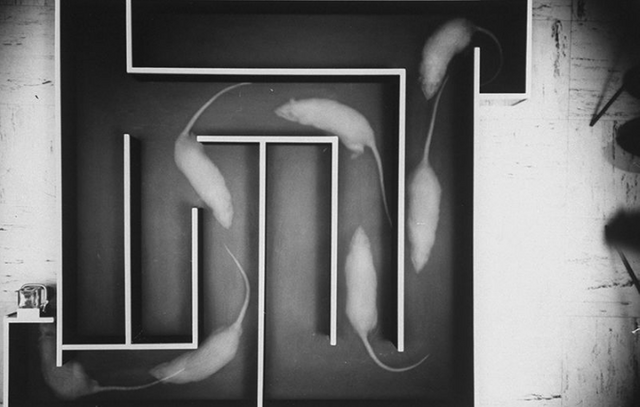Brain Navigation Map
“It is striking that the computer model, coming from a totally different perspective, ended up with the grid pattern we know from biology” said Mozerd 2014 Nobel Prized Winner.

Scientists have used artificial intelligence (AI) to recreate the complex neural codes that the brain uses to navigate through space. The feat demonstrates how powerful AI algorithms can assist conventional neuroscience research to test theories about the brain’s workings — but the approach is not going to put neuroscientists out of work just yet, say the researchers.
neuroscientists at University College London (UCL) and AI researchers at the London-based Google company DeepMind. It used a technique called deep learning — a type of AI inspired by the structures in the brain — to train a computer-simulated rat to track its position in a virtual environment.
The program surprised the scientists by spontaneously generating hexagonal-shaped patterns of activity akin to those generated by navigational cells in the mammalian brain called grid cells. Grid cells have been shown in experiments with real rats to be fundamental to how an animal tracks its own position in space.
What’s more, the simulated rat was able to use the grid-cell-like coding to navigate a virtual maze so well that it even learnt to take shortcuts.
“This paper came out of the blue, like a shot, and it’s very exciting,” says neuroscientist Edvard Moser at the Kavli Institute for Systems Neuroscience in Trondheim, Norway. Moser shared the 2014 Nobel Prize in Physiology or Medicine for his co-discovery of grid cells and the brain’s other navigation-related neurons, including place cells and head-direction cells, which are found in and around the hippocampus region. The work is a welcome confirmation that the mammalian brain has developed an optimal way of arranging at least this type of spatial code.
“It will be extremely interesting to analyse the inner workings of the deep-learning system and see whether the authors have discovered a universal computational principle that aids spatial navigation,” says computational neuroscientist Andreas Herz at the Ludwig Maximilian University of Munich in Germany.

Deep-learning rats
The study authors set out to use deep-learning networks — which are based on recurrent computational units that communicate with each other — to test a hypothesis in neuroscience: that the brain, using grid cells, maps its position in an environment by integrating information about the speed and direction of the body’s movement.
First, the authors generated data to train their algorithm. They simulated pathways taken by virtual rats as they foraged in enclosures, as well as the activity of place and head-direction cells as the simulated rodents moved around — but not of grid cells. They then used these data to train the deep-learning networks to recognize the position of the simulated rats. As the researchers did so, they found that hexagonal patterns of grid-like activity emerged spontaneously in the computational units — just as they do in the brains of real rats in lab experiments.
“We’d been hopeful of seeing the grids, but were still surprised to see them in this context,” says UCL neuroscientist Caswell Barry, a co-author of the study. “I’ve seen them many times in experiments, and they are so beautiful in their regularity.”
The scientists were also intrigued to find that they needed to tweak the system to add some artificial noise — making its units tick more similarly to those in the brain — to get the grid-like activity to emerge. “This is something we theoretical neuroscientists have been thinking about, but also couldn’t test,” says Herz.
Then the researchers put the system through its paces, testing whether virtual rats could use it to navigate. They placed the simulated rodents in a larger enclosure designed as a maze, where the virtual rats had to learn to make their way to a specific goal. The authors added another program to the system that introduced the memory and reward functions necessary for learning. The simulated rats soon learnt to find their goals through trial and error, and became so proficient that they outperformed a human expert who attempted the same task and started to take shortcuts.
The researchers found that if they intentionally prevented the grid patterns from forming, the simulated rats could no longer efficiently navigate the maze. “Shutting down grid cells is something that can’t be done in an experimental rat,” says Barry.
The collaboration with neuroscientúists has inspired AI research, says DeepMind researcher and study co-author Andrea Banino. “But right now it is purely basic research into making intelligent algorithms, and not about applications,” he says.
Researchers agree that AI will be a useful tool for testing hypotheses about the brain, but that it is unlikely to answer questions about how and why the brain comes to use a particular code. “I was really excited when I read the paper — it seems that AI may be able to accelerate our research into how the brain navigates,” says Moser. But it won’t usurp neuroscientists, he says.
Thanks to:
University College London (UCL)
Nature: International Journal of Science. Alison Abbott.
Dude AI is going to get so wild. I was reading a book (had to put it down for a minute though) called The Master Algorithm. Pretty nuts where this is all going, although in so many ways we are so far down this path already. Thanks for sharing!
You got a 5.07% upvote from @emperorofnaps courtesy of @fanservice!
Want to promote your posts too? Send 0.05+ SBD or STEEM to @emperorofnaps to receive a share of a full upvote every 2.4 hours...Then go relax and take a nap!